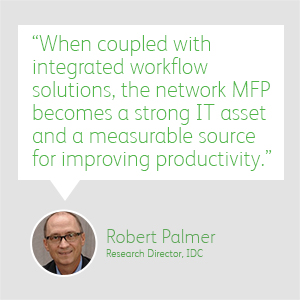 In today’s ultra-competitive environment, success in the imaging industry hinges on the ability to expand beyond the core business of printing. With revenue from basic print services on the decline, providers must augment their MPS programs with value-add solutions to drive alternative revenue streams and increase profits. For many, document workflow optimization represents the best opportunity to increase customer spend and realize net new sales through adjacent business opportunities.
In today’s ultra-competitive environment, success in the imaging industry hinges on the ability to expand beyond the core business of printing. With revenue from basic print services on the decline, providers must augment their MPS programs with value-add solutions to drive alternative revenue streams and increase profits. For many, document workflow optimization represents the best opportunity to increase customer spend and realize net new sales through adjacent business opportunities.
Nevertheless, the progression from managed print services to managed document services (MDS) can be challenging. On the business model side, changes in go-to-market strategies and service delivery are only part of the equation. How do we compensate sales people for a solutions sale? How do we develop the technical expertise and infrastructure resources necessary to support various customer needs?
At the same time, there are just as many technology issues to resolve. Many service providers have shied away from high-value document solutions and services due to the abundance of software choices and concerns over upfront investment costs.
Fortunately, some equipment manufacturers are making it easier for channel partners by developing complete solutions ecosystems around the MFP. The intent is to help facilitate the delivery of value-add solutions optimized for specific applications and vertical markets. A well-integrated solutions ecosystem can provide plug-and-play capabilities for MPS tools, software programs, and apps in areas such as print and device management, security, document management, and document workflow.
Following Market Demand
For those service providers looking to expand the value of their MPS offerings, building a strong document management and workflow practice can be a sound investment. For most businesses, information management has become a top priority. The transition to mobile technologies, cloud computing, and the fully connected digital office has changed the way we work, and many of those changes revolve around the basic need to manage and control access to information.
According to IDC’s recently published Print and Document Management MaturityScape Benchmark Survey, businesses view content management and process optimization as strategic business priorities. Asked about their organization’s plans for the next 12-18 months for print and document management programs, 20% of respondents say they plan to proactively convert paper-based workflows to digital workflows.
At the same time, 20% of respondents also note plans to streamline and automate document-intensive business processes. This research underscores current business spending trends and points to managed document services as a key growth area for service providers across various channels and routes to market.
From a business model perspective, transitioning from MPS to MDS may not be as difficult as once considered. There are many correlations to be made between a traditional print-centric practice and one that is differentiated through high-value document solutions and services—utilizing the MPS foundation as a pathway to managed document services.
Smart MFP Equals Smart Workflow
So, what is the bridge to MDS? What are the components of a managed document services practice and how do you fold those into the services you are already providing? It is best to simply think of it as an evolution of MPS, but shifting the focus from devices and hardware to content. The core structure of the managed document solution is basically identical to that of MPS: bundling software, solutions, and support into a packaged service to help customers deal with issues around content management, collaboration, storage, retrieval, and distribution.
In addition, these solutions must be integrated with core capabilities in content security and the conversion from paper to digital. The ultimate goal is to free up access to information, and begin to simplify and automate certain business processes to help your customers become more productive.
The best place to start is by integrating solutions that are optimized for the smart MFP. To address the changing demands for today’s office environment, businesses need an integrated document infrastructure built around four key elements: print management, intelligent capture and conversion, collaboration tools, and automated document workflow. These four elements, deployed through an integrated solution at the MFP, can deliver the comprehensive information management capabilities needed to address most critical business objectives.
Many businesses and even MPS providers fail to recognize the importance of the network MFP as the best foundation for integrating these solutions together. Combined with scanning software and intelligent workflow tools, the network MFP offers the ability to convert paper to digital format at the most opportune point in the overall process. This is how businesses can begin to automate processes and drive real efficiencies into existing business workflow.
When coupled with integrated workflow solutions, the network MFP becomes a strong IT asset and a measurable source for improving productivity. Businesses can dramatically cut costs by reducing print consumption and eliminating non-essential paper, gain control over key business processes to improve productivity, drive efficiencies by automating workflow, and manage content security while providing access to information when and how it is needed.
The network MFP combined with a well-integrated solutions ecosystem can now be positioned as a gateway to fully integrated digital workflow. This is important, especially for small businesses looking to achieve operational efficiencies on a limited budget. Sourcing and deploying the necessary software components across multiple scanners and printers is very costly and difficult to manage. The more effective alternative is to move these activities to fewer, but more powerful MFPs.
Measuring Success
As previously mentioned, deploying the right software and technology is only part of the equation. When it comes to measuring the effectiveness of your new document management or workflow services practice, consider separating these units from your core business.
Every business has what could be considered its performance engine, the bread and butter product or service that currently serves as the foundation of everything you do. For many channel partners this is your MPS business, but for others it is different. Often, there is a tendency to measure new business ventures using the same metrics that are applied to the old one, which may not provide an effective baseline and could limit opportunities for long-term success.
Your new line of business is where you are hoping to drive innovation and growth – through software, solutions, or managed document services. Your performance engine is hopefully stable and already performing as a healthy business. That business is likely measured against typical financial metrics such as P&L, cash flow, margin, etc.
However, if you use only these metrics to measure the performance of the new line of business there is a potential to miss some underlying important variables. Consider also measuring against other variables, such as the number of new subscribers, software attach rates, hardware pull-through rates, and tracking net new customers, for example.
Staying Relevant in a Mature Market
To remain relevant in the printing industry, channel partners must look to shift a substantial portion of their revenue mix away from imaging hardware and supplies. The search for adjacencies has been underway for quite some time. Many are looking at entirely new product segments, such as wide-format, 3D printing, or production and graphic arts. For many, however, the transition to document workflow and managed document services is attractive because it allows the provider to leverage core competencies in the office printing space.
A good document management ecosystem is essential in helping businesses manage information. Service providers have a host of options available, but it is best to find an OEM partner with a hardware and solutions ecosystem that addresses the core elements of document capture and conversion, OCR capabilities, workflow automation, document collaboration tools, cloud storage, backup and restore tools, content security, and the hooks necessary to integrate with existing applications and business systems.
An effective document management practice will leverage integrated software and tools to help you as a provider go beyond print-centric services to turn customer printing resources into a source for productivity. You can strengthen your customer relationships to become an indispensable partner and drive value and profits for your customer, which translates to repeatable business and makes it difficult for competitors to displace you.
 Learn more about Xerox Partner Print Services
Learn more about Xerox Partner Print Services
Learn more about adding managed print services to your portfolio and find out about becoming accredited to sell Xerox Partner Print Services on the Xerox Global Partner Portal.
Join our Xerox Channel Partners LinkedIn Community
Looking for more marketing tips and insights from Xerox Agents, Concessionaires, and Document Technology partners from across the globe? Join our private Xerox Channel Partners LinkedIn Group to connect and discuss topics like these with your peers.
Subscribe to the Channel Partner Connection and receive email updates when we publish a new article.[wysija_form id=”1″]



